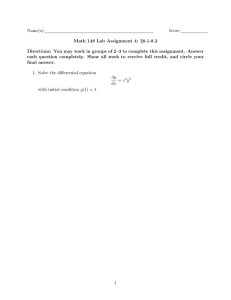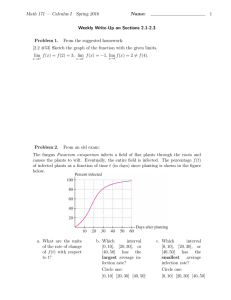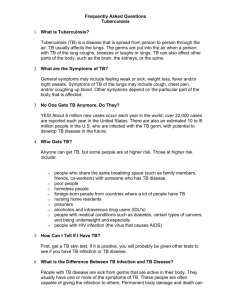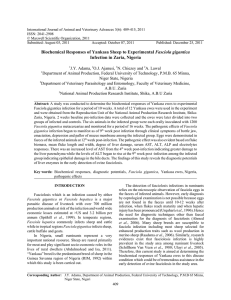Fasciola gigantica
advertisement
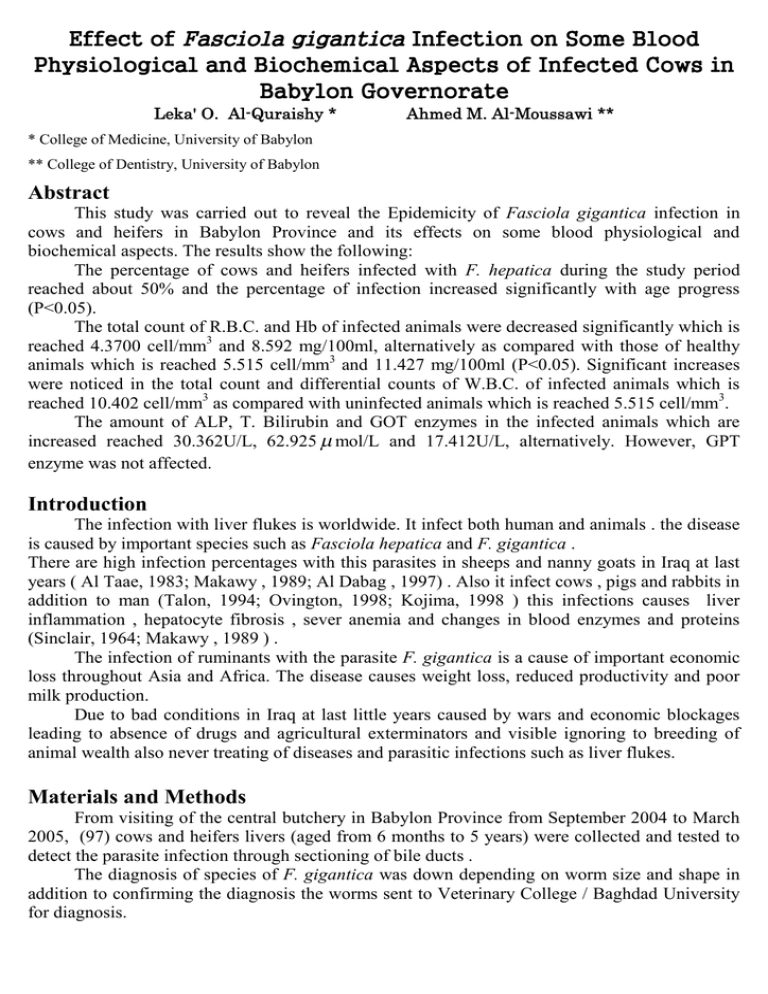
Effect of Fasciola gigantica Infection on Some Blood Physiological and Biochemical Aspects of Infected Cows in Babylon Governorate Leka' O. Al-Quraishy * Ahmed M. Al-Moussawi ** * College of Medicine, University of Babylon ** College of Dentistry, University of Babylon Abstract This study was carried out to reveal the Epidemicity of Fasciola gigantica infection in cows and heifers in Babylon Province and its effects on some blood physiological and biochemical aspects. The results show the following: The percentage of cows and heifers infected with F. hepatica during the study period reached about 50% and the percentage of infection increased significantly with age progress (P<0.05). The total count of R.B.C. and Hb of infected animals were decreased significantly which is reached 4.3700 cell/mm3 and 8.592 mg/100ml, alternatively as compared with those of healthy animals which is reached 5.515 cell/mm3 and 11.427 mg/100ml (P<0.05). Significant increases were noticed in the total count and differential counts of W.B.C. of infected animals which is reached 10.402 cell/mm3 as compared with uninfected animals which is reached 5.515 cell/mm3. The amount of ALP, T. Bilirubin and GOT enzymes in the infected animals which are increased reached 30.362U/L, 62.925 mol/L and 17.412U/L, alternatively. However, GPT enzyme was not affected. Introduction The infection with liver flukes is worldwide. It infect both human and animals . the disease is caused by important species such as Fasciola hepatica and F. gigantica . There are high infection percentages with this parasites in sheeps and nanny goats in Iraq at last years ( Al Taae, 1983; Makawy , 1989; Al Dabag , 1997) . Also it infect cows , pigs and rabbits in addition to man (Talon, 1994; Ovington, 1998; Kojima, 1998 ) this infections causes liver inflammation , hepatocyte fibrosis , sever anemia and changes in blood enzymes and proteins (Sinclair, 1964; Makawy , 1989 ) . The infection of ruminants with the parasite F. gigantica is a cause of important economic loss throughout Asia and Africa. The disease causes weight loss, reduced productivity and poor milk production. Due to bad conditions in Iraq at last little years caused by wars and economic blockages leading to absence of drugs and agricultural exterminators and visible ignoring to breeding of animal wealth also never treating of diseases and parasitic infections such as liver flukes. Materials and Methods From visiting of the central butchery in Babylon Province from September 2004 to March 2005, (97) cows and heifers livers (aged from 6 months to 5 years) were collected and tested to detect the parasite infection through sectioning of bile ducts . The diagnosis of species of F. gigantica was down depending on worm size and shape in addition to confirming the diagnosis the worms sent to Veterinary College / Baghdad University for diagnosis. 1 The blood specimens was collected from the animals before the butchering and placed in both heparinized and non heparinized tubes (Schaim et al., 1972). The blood physiological and biochemical testes was don as follows: 1- Red Blood Cells Count: R.B.C. count was made according to Hall and Malia (1984). 2- Hemoglobin Assessment: By using of HB Meter and depending on Sood (1992). 3- White Blood Cells Count: W.B.C. count was made according to Brown (1976). 4- Differential Leukocytes Count: D. L. count was down By making of blood smears and depending on Brown (1976). 5- Serum GPT and GOT Assessment: S. GPT and GOT were determine consistent with Randox Co. kit . 6- Serum Bilirubin Assessment: S. B. was determine consistent with Biomacrib Co. kit . 7- Serum Alkaline Phosphatase Assessment: S. ALP was determine consistent with Biomacrib Co. kit . Statistical Analysis Chi square test, and analysis of variance (Campbell, 1967) were employed for the statistical analysis. Results Figure (1) reveals the identification of species of F. gigantica. Figure (1) : F. gigantica 1- Infection percent The total infection percentage of cows with F. gigantica is 50% divided into 31.7% for males and 64.2% for females with. Significant differences were noticed (P≤ 0.05) Table (1). Table (1): Numbers and infection percentages of infected cows with F. gigantica. Sex Male Female Sum. Number of Total Animal Tested 41 56 97 Number of Infected Animals 13 36 49 * Significant differences (P≤ 0.05). 2 Infection Percentage 31.7 64.2* 2- Effect of the infection with F. gigantica on some blood physiological and biochemical parameters. Table (2) show significant decreasing (P≤ 0.05) in total R.B.C. (4.3700 cell/mm3) and Hb value (8.592 mg/100ml ) in infected animals in comparison with non infected animals total R.B.C. and Hb value were (5.515 cell/mm3) and (11.427 mg/100ml ) . Total W.B.C. (10.402 cell/mm3) show significant increasing in infected animals in comparison with non infected animals (5.515 cell/mm3). Table (2): Effect of the infection with F. gigantica on some blood physiological parameters. Treatment Infected animals Non infected animals Red Blood Cells × 106cell/mm3 4.3700 5.148 Hemoglobin mg/100 ml 8.592 0.1166 White Blood Cells × 106cell/mm3 10.402 0.2303 a a a 5.515 4.911 11.427 0.1456 5.515 4.911 b b b The number of Eosinophile (7.178%) increased significantly (P≤ 0.05) in infected animals . There are no changes in numbers of lymphocytes, neutrophiles and monocytes in both infected animals and non infected animals (table 3). Table (3): Effect of the infection with F. gigantica on differential leukocytes . Infection Infected animals Non infected animals Lymphocyte Neutrophile Monocyte Eosinophile 68.075 0.6008 26.95 0.417 2.48 0.6122 7.187 2.585 * 68.025 0.5808 26.48 0.459 1.82 9.205 4.687 1.097 * * Significant differences (P≤ 0.05). The results in table (4) show significant increasing (P≤ 0.05) in S.T.B. (30.362 mol/L), S.A.L.P. (62.925 U/L) and S.G.O.T. (17.4125 U/L) in infected animals in comparison with non infected animals. There is no change in S.G.P.T. in both infected animals and non infected animals. Table (4): Effect of the infection with F. gigantica on liver enzymes. Infection Infected animals Non infected animals T.Bilirubin ALP S.G.O.T. S.G.P.T mol/L U/L U/L U/L 30.362 1.315 62.925 1.155 17.4125 7.1294 12.3000 0.2914 a a a a 13.037 0.3699 39.475 10.336 13.575 0.7735 12.2875 0.3233 b b b b Different letters means significant differences. 3 Discussion The infection percentage of cows with F. gigantica (50%) was high (table 1). increasing number of infected animals due to the grazing of this animals in contaminated areas with snails such as Lymnea spp. That represents the intermediate host for F. gigantica. Also there is no controlling for these snails in these areas, In addition to absence of persons knowledge how work in cows breeding (Petalia, 2000). The blood physiological testes show decreasing in R.B.C. and H.B. while number of W.B.C. was increased significantly (table 2). These results agreed with Makawy (1989) and Abood (1992). This parasite infection causes anemia due to some reasons such as mechanical injuries of worms migration in liver tissue causing intensive bleeding, in chronic infection anemia caused by parasite blood sucking, removing of epithelium lining bile duct (Makawy ,1989; Abood ,1992) . Dargie and Berry (1978) pronounced that anemia in infected animals resulting from haemodilution, intrahepatic hemorrhage and Billiary hemorrhage. Anemia occurred because of iron massive utilization by animal body to restitution missed iron and intestine unable for absorption iron again (Dargie, 1975; Dargie and Mulligen, 1970). The reasons of R.B.C. deficiency are bleeding and insufficient of bon marrow responding to new R.B.Cs. formation because of the infection in addition to sucking of 0.2 ml of blood daily by worms and bleeding of 0.5 ml of blood daily in muscles also flow of immature R.B.C. to the circulatory system (Ali, 1984; Abass, 1980; Sewell and Hammond, 1968). Increasing of Eosinophiles in infected cows in comparison with non infected others (table 3) resulting from ability of Eosinophiles to destroy the parasites larval stages by their attachment on parasite wall and secretion of granules act in external parasite wall destructing (Roberts, 1968; Al-Zubaidy, 1989; Al-Kubassie, 1996) . In general the increasing of leukocytes due to cellular immunity as responding of cells that able to attached antigens and encircle it, finally digest it by phagocytsosis in addition to lymphocyte activity such as T- lymphocyte and plasma cell (Maclaren and Lacani, 1982; Tizard, 1987). The results in table (4) show increasing of S.G.O.T. that agreed with Ross et al. (1967) that the elevation of S.G.O.T. indicates to hepatocyte damage and it important to assessment the degree of hepatocyte damage or liver fluke infection. Thorpe (1965) indicated that the S.G.O.T. is more sensitive than S.G.P.T to liver tissue destroying; S.G.P.T is low response to hepatocyte damage (Yasuda, 1988). Increasing of S. T. Bilirubin and S.G.P.T due to hepatocyte death from liver fluke infection. In addition to complete or partial bile ducts obstruction causing returning of Bilirubin to hepatocyte then increased it in serum and elevation of S.G.P.T (Dias, 1996; Pulperio, 1991; Kilad et al., 2000). References Abass, M.K. (1980). Laboratory studies of some liver worms respects in Iraq species Fasciola gigantica. M.Sc. thesis, Coll. Veter. , Univ. Baghdad. (In Arabic). Abood, R. A. (1992). Study of some practical and biochemical changes resulting from infection with liver worm Fasciola gigantica in three strains of Iraqi sheeps . M.Sc. thesis, Coll. Veter. , Univ. Baghdad. (In Arabic). 4 Al-Dabag , A.T.M. (1997). Infection with liver parasitic worms in sheeps and nanny goats in Baghdad butchery J. Veter. 6(7): 6-10. (In Arabic). Al-Taae, L.H.K.(1983). A Survey for buffalo parasites with study of intermediate host of Gigantcotyle explanatue .M.Sc. thesis, Coll. Veter. , Univ. Baghdad. (In Arabic). Ali , S.A.K. (1984). Effect Study of the infection with liver worms species Fasciola gigantica in domestic nanny goats and compare it with awasy sheeps in Iraq . M.Sc. thesis, Coll. Veter., Univ. Baghdad. (In Arabic). Al-Kubaisse, R.y. (1996). Bioimmunological study for some antigens of F. gigentica. Ph.D. Thesis. college of veterinary medicine, university of Baghdad. Al-Zubaidy, I.A. (1989). Study of cellular Response in ewas infected with lung worms Dictyocanlus filarial M.Sc. Thesis. college of Vet. Medicine. University of Baghdad Brown, B.A. (1976) Heamatolgy in principle and proced. 2nd. lea and febiger, Philadelphia. U.S.A. Campbell, R.C. (1967) Statistics for biologists .Cambridge Univ. Press: 242 pp. Dargi, J.D. and Mulligan, W. (1970) Ferrokinetics studing on normal and flukes infected rabbits. J. comp. path., 80, 37-45. Dargie, J.D. and Berry, C.I. (1978). The hypo albuminiae of Ovin fascioliasis : the Influence of protein intake on the albumin metabolisim of infected and of pair. fed control sheep. Int. G.parasite. 9, 17-25. Dargie, J.D.(1975). pathophysiology fascioliasis in Helminth diseases of cattle, sheep and horses in Eurpe. proceeding of workship Held at Veterinary School of University of Glasgow (ed), G.M Urquhart and J. Armour, 81-114. Dargie, J.D.; Berry, C.I. and Parkins, J.J. (1979). The pathophysiology of Ovin of fascioliasis: studies on the feed intake and digestibility. Body weight and Nitrogen balance of sheep given Ratio of hay on hay plus apelleted supplement kes. vet. Sci.; 26 : 289-295 Dias, L.M; Silvar, G.R.; Viana H.L (1996). Biliary fascioliasis diagnosis, treatment and follow up by ERcp. Gastrointestinal Endoscopy ; 1996 ; 43; 16-20. Hall, R. and Malia, R.G. (1984). Medical laborary Heamatology. Butter worms, London. Kilad, Z.M.; Chpashvili L.; Abuladze, D. and Jath., V.D. (2000). Obstruction of common bile duct caused by liver fluke Fasciola hepatica, sblek; 101 (3) 255-9. Kojima, S. (1998). Scistosomiasis in: Microbiology and microbial infection cox, F.E.G., Kreler, J.P. and Wakalin, D. (eds) Vol.5.9th ed. Arnold. Press, London. PP. 480-503. Maclaren, D.J. and Lcani, R.N. (1982). Schistosoma mansoni – Acquired resistence of developing Schistosoma to immune attack invitro. Exp. Parositol.; 53, 285-298. 5 Makawy , T. (1989). Study of pathological changes for domestic cows that infected naturally with liver parasites Fasciola hepatica J. Iraqi Veter. Vol. (4). (In Arabic). Ovington, K.S. (1998). Fascioliasis. In: Encyclopedia human immunology. 2nd ed.pelves, P.J. and Roitt, I.M. (eds). Academic press, U.S.A. pp:880-884. Petalia, T.M. (2000). Chronic fascioliasis is the most common clinical syndrome assosciated with liver fluke infection in sheep and cattle Bellow is acache of http://www.Petalia.com.an /templates /story templates. Pulperio, J.R.; Armestor, V.J. and Carredoina .J. (1991). Facioliasis finding in 15 patient. Br. J. Radiola 64(765). Roberts, H.E (1968). Observation on experimental acute fascioliasis in sheep.Br. Vet. J. 124 :433. Ross, J.G. (1967). An epidemiological study fascioliasis in sheep Vet. Rec.; 80 : 214-217. Schalm, O.W.; Jain, N.C. and Nnall, E.J. (1972). Veterinary heamatology. 3rd edition. lea and Febigent. Sewell, M.M.H.; Hammoud, J.A. and Dinning, D.C. (1968). Studies on the etiology of anemia in chronic fascioliasis in sheep. Brit. Vet. J., 124:160-170. Sinclair, K.B. (1964). Observation on the clinical pathology of ovin fascioliasis. Brit. Vet. J., 118:37-53. Sood, R. (1992). Technology of medical laboratory methods explanations. Translated: Dr. Saleh , K.H.; Abed-Alrazak , J. and Baker A. , Ministry of Higher Education and Scientific Research. (In Arabic). Thorpe, E. (1965). Liver damage and the host parasite. Tizard, I. (1987). Veterinary Immunology. An Introduction.3th edition W.B. Sandarers company Philadelphia. London, Toronto. Tolan, R.W. (1994). Fascioliasis. J. Med., 79(3): Yasuda, J. (1988). Jap. J. Vet. Sci., 50:71. 6 ﺗﺄﺛﯿـﺮ اﻹﺻﺎﺑـﺔ ﺑﺪودة اﻟﻜﺒــﺪ Fasciola giganticaﻓﻲ ﺑﻌﺾ ﻣﻌﺎﯾﯿﺮ اﻟﺪم اﻟﻔﺴﻠﺠﯿﺔ واﻟﻜﯿﻤﻮﺣﯿﻮﯾﺔ ﻟﻼﺑﻘﺎر اﻟﻤﺼﺎﺑﺔ ﻓﻲ ﻣﺤﺎﻓﻈﺔ ﺑﺎﺑﻞ اﺣﻤﺪ ﻣﺤﻤﺪ اﻟﻤﻮﺳﻮي** ﻟﻘﺎء ﻋﺪي اﻟﻘﺮﯾﺸﻲ* * ﻛﻠﯿﺔ اﻟﻄﺐ /ﺟﺎﻣﻌﺔ ﺑﺎﺑﻞ ** ﻛﻠﯿﺔ ﻃﺐ اﻻﺳﻨﺎن /ﺟﺎﻣﻌﺔ ﺑﺎﺑﻞ ﺍﻟﺨﻼﺼﺔ : ﺘﻨﺎﻭﻟﺕ ﻫﺫﻩ ﺍﻟﺩﺭﺍﺴﺔ ﻭﺒﺎﺌﻴﺔ ﺍﻻﺼﺎﺒﺔ ﺒﺩﻭﺩﺓ ﺍﻟﻜﺒﺩ Fasciola giganticaﻓﻲ ﺍﻻﺒﻘﺎﺭ ﻭﺍﻟﻌﺠﻭل ﺒﻤﺤﺎﻓﻅﺔ ﺒﺎﺒل ﻭﺘﺎﺜﻴﺭ ﻫﺫﻩ ﺍﻻﺼﺎﺒﺔ ﻋﻠﻰ ﺒﻌﺽ ﻤﻌﺎﻴﻴﺭ ﺍﻟﺩﻡ ﺍﻟﻔﺴﻠﺠﻴﺔ ﻭﺍﻟﻜﻴﻤﻭﺤﻴﻭﻴﺔ ﻭﺘﻡ ﺍﻟﺘﻭﺼل ﺍﻟﻰ ﺍﻟﻨﺘﺎﺌﺞ ﺍﻻﺘﻴﺔ : ﻜﺎﻨﺕ ﻨﺴﺒﺔ ﺍﻻﺼﺎﺒﺔ ﺍﻟﻜﻠﻴﺔ ﻓﻲ ﺍﻻﺒﻘﺎﺭ ﻭﺍﻟﻌﺠﻭل ﺒﺩﻭﺩﺓ ﺍﻟﻜﺒﺩ F. giganticaﺒﻬﺫﻩ ﺍﻟﺩﺭﺍﺴﺔ %50ﻭﺘﺯﺩﺍﺩ ﻫﺫﻩ ﺍﻟﻨﺴﺒﺔ ﻤﻌﻨﻭﻴﺎ ﻤﻊ ﺯﻴﺎﺩﺓ ﺍﻟﻌﻤﺭ . ﺍﻟﻌﺩﺩ ﺍﻟﻜﻠﻲ ﻟﻜﺭﻴﺎﺕ ﺍﻟﺩﻡ ﺍﻟﺤﻤﺭ ﻭﻜﻤﻴﺔ ﺨﻀﺎﺏ ﺍﻟﺩﻡ ﺘﻨﺎﻗﺹ ﺒﺸﻜل ﻤﻌﻨﻭﻱ ﻓﻲ ﺍﻟﺤﻴﻭﺍﻨﺎﺕ ﺍﻟﻤﺼﺎﺒﺔ ﻭﻭﺼل ﺍﻟﻰ 4.3700 ﺨﻠﻴﺔ /ﻤﻠﻡ 3ﻭ 8.592ﻤﻠﻐﻡ 100 /ﻤل ،ﻋﻠﻰ ﺍﻟﺘﻭﺍﻟﻲ ﺒﺎﻟﻤﻘﺎﺭﻨﺔ ﻤﻊ ﺍﻟﺤﻴﻭﺍﻨﺎﺕ ﺍﻟﻐﻴﺭ ﻤﺼﺎﺒﺔ ﺤﻴﺙ ﻜﺎﻨﺕ 5.515ﺨﻠﻴﺔ /ﻤﻠـﻡ 3 ﻭ 11.427ﻤﻠﻐﻡ 100 /ﻤل ،ﻋﻠﻰ ﺍﻟﺘﻭﺍﻟﻲ ﻭﺘﺤﺕ ﻤﺴﺘﻭﻯ ﺩﻻﻟﺔ . 0.05 ﺍﺯﺩﺍﺩ ﻤﻌﻨﻭﻴﺎ ﺍﻟﻌﺩﺩ ﺍﻟﻜﻠﻲ ﻟﻜﺭﻴﺎﺕ ﺍﻟﺩﻡ ﺍﻟﺒﻴﺽ ﻓﻲ ﺍﻟﺤﻴﻭﺍﻨﺎﺕ ﺍﻟﻤﺼﺎﺒﺔ ﻭﺒﻠﻎ 10.402ﺨﻠﻴﺔ /ﻤﻠﻡ 3ﺒﺎﻟﻤﻘﺎﺭﻨﺔ ﻤﻊ ﺍﻟﺤﻴﻭﺍﻨﺎﺕ ﻏﻴﺭ ﺍﻟﻤﺼﺎﺒﺔ ) 10.402ﺨﻠﻴﺔ /ﻤﻠﻡ. ( 3 ﻜﻤﻴﺔ ﺍﻟﺒﻴﻠﺭﻭﺒﻴﻥ ﺍﻟﻜﻠﻲ ﻭﺍﻨﺯﻴﻤﺎﺕ A.L.P.ﻭ G.O.T.ﻓﻲ ﺍﻟﻤﺼل ﺍﺯﺩﺍﺩ ﻤﻌﻨﻭﻴﺎ ﻓـﻲ ﺍﻟﺤﻴﻭﺍﻨـﺎﺕ ﺍﻟﻤﺼـﺎﺒﺔ ﻭﻜـﺎﻥ 62.925ﻤﺎﻴﻜﺭﻭﻤﻭل /ﻟﺘﺭ 30.362 ،ﻭﺤﺩﺓ /ﻟﺘﺭ ﻭ 17.412ﻭﺤﺩﺓ /ﻟﺘﺭ ،ﻋﻠﻰ ﺍﻟﺘﻭﺍﻟﻲ ﺒﻴﻨﻤﺎ ﻟﻡ ﺘﺘﺄﺜﺭ ﻜﻤﻴﺔ ﺍﻨﺯﻴﻡ G.P.T. ﻓﻲ ﺍﻟﻤﺼل . 7



